|
The Brit-Am Rose |
|
The Brit-Am Rose |
|
Brit-Am Discussion Group |
Contents by Subject |
Research Revelation Reconciliation Contribute |
|
Site Map Contents in Alphabetical Order |
This Site |
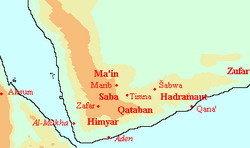 Southern Arabia shows location of Saba |
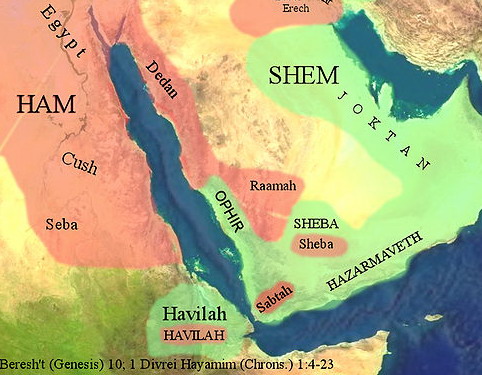 Southern Arabia shows location of Saba as Sheba. Placement on map of Ophir in Southern Arabia is probably mistaken. Likewise location of Havilah needs clarification. |
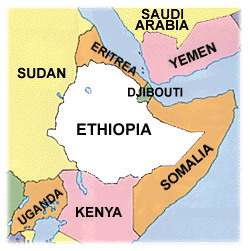 |
Quotation:
One local Yemenite Jewish tradition
dates the earliest settlement of Jews in the Arabian Peninsula to the time of
King Solomon. One explanation is that King Solomon sent Jewish merchant marines
to Yemen to prospect for gold and silver with which to adorn the Temple in
Jerusalem.[1] In 1881, the French vice consulate in Yemen wrote to the leaders
of the Alliance in France, that he read a book of the Arab historian Abu-Alfada,
that the Jews of Yemen settled in the area in 1451 BCE.[2] Another legend places
Jewish craftsmen in the region as requested by
Bilqis,
the Queen of Saba (Sheba). The Beta Israel or
Chabashim
(Jews in nearby Ethiopia) have a sister legend of their origins that places the
Queen of Sheba as married to King Solomon. Parts of Yemen, Eritrea and Ethiopia
at that time were jointly ruled by Sheba, with its capital in Yemen.[3]
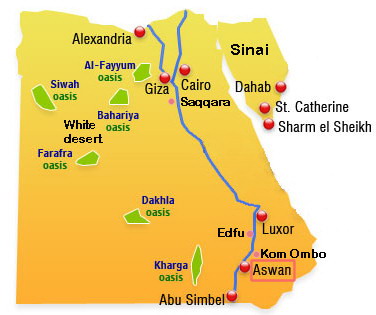 There was an Ancient Israelite or Judaean colony at Elephantine (Aswan) in Southern Egypt near the border with Sudan. |
By STEPHEN GABRIEL ROSENBERG
Extract Only:
Two major questions remain. Where had
the Jews come from in the sixth century and where did they go after 400 BCE? The
simple answer to the first question is that they would have come after the fall
of Jerusalem in 586 BCE and gone down to Egypt with Jeremiah after the murder of
the governor Gedaliah.
But Porten
thinks they must have come much earlier, at the time when King Manasseh defiled
the Jerusalem temple, to be able to find the resources to settle and build a
temple well before 525 BCE. We know the shrine existed before the invasion by
Cambyses,
as the papyri claim that he destroyed many Egyptian temples but not the Jewish
one.
I think the Jews came from the Northern
Kingdom after the fall of Samaria in 722 BCE. They were first deported to
Assyria and then to Babylon, where they were used as mercenaries and later
deployed to Egypt. This is supported by the fact that the shrine at Elephantine
has strong similarities in layout and dimensions to the Tabernacle that may have
stood at Shiloh, and which would have been retained in the folk memory of the
Northern Israelites more than the image of the Temple of Jerusalem.
And to where did they go? It would have
been impossible for them to return to Israel, trekking 700 km. and more to the
north through what was now enemy territory. It is more likely they went south
and here a romantic idea presents itself. They journeyed south through the Sudan
to Ethiopia and formed the nucleus of a Jewish community there, perhaps even
starting to convert their neighbors to Judaism.
That would be a nice idea, but an
unlikely one. It is more probable that the Jewish military community, which came
to an end 2,400 years ago, was either eliminated by the Egyptians or, more
likely, abandoned its separate faith and customs and became absorbed by its
Egyptian neighbors, which would not have been so strange, as many had already
married local girls in earlier times.
In short there was a Jewish or Israelite
colony at Elephantine (Aswan) and from here too settlers may have arrived in
Ethiopia.
[1-Kings 10:3] AND SOLOMON TOLD HER ALL
HER QUESTIONS: THERE WAS NOT ANY THING HID FROM THE KING, WHICH HE TOLD HER
NOT.
[1-Kings 10:4] AND WHEN THE QUEEN OF
SHEBA HAD SEEN ALL SOLOMON'S WISDOM, AND THE HOUSE THAT HE HAD
BUILT,
[1-Kings 10:5] AND THE MEAT OF HIS
TABLE, AND THE SITTING OF HIS SERVANTS, AND THE ATTENDANCE OF HIS MINISTERS, AND
THEIR APPAREL, AND HIS CUPBEARERS, AND HIS ASCENT BY WHICH HE WENT UP UNTO THE
HOUSE OF THE LORD; THERE WAS NO MORE SPIRIT IN HER.
[1-Kings 10:6] AND SHE SAID TO THE KING,
IT WAS A TRUE REPORT THAT I HEARD IN MINE OWN LAND OF THY ACTS AND OF THY
WISDOM.
[1-Kings 10:7] HOWBEIT I BELIEVED NOT
THE WORDS, UNTIL I CAME, AND MINE EYES HAD SEEN IT: AND, BEHOLD, THE HALF WAS
NOT TOLD ME: THY WISDOM AND PROSPERITY
EXCEEDETH
THE FAME WHICH I HEARD.
[1-Kings 10:8] HAPPY ARE THY MEN, HAPPY
ARE THESE THY SERVANTS, WHICH STAND CONTINUALLY BEFORE THEE, AND THAT HEAR THY
WISDOM.
[1-Kings 10:9] BLESSED BE THE LORD THY
GOD, WHICH DELIGHTED IN THEE, TO SET THEE ON THE THRONE OF ISRAEL: BECAUSE THE
LORD LOVED ISRAEL FOR EVER, THEREFORE MADE HE THEE KING, TO DO JUDGMENT AND
JUSTICE.
[1-Kings 10:10] AND SHE GAVE THE KING AN
HUNDRED AND TWENTY TALENTS OF GOLD, AND OF SPICES VERY GREAT STORE, AND PRECIOUS
STONES: THERE CAME NO MORE SUCH ABUNDANCE OF SPICES AS THESE WHICH THE QUEEN OF
SHEBA GAVE TO KING SOLOMON.
[1-Kings 10:11] AND THE NAVY ALSO OF
HIRAM, THAT BROUGHT GOLD FROM
OPHIR, BROUGHT IN FROM
OPHIR
GREAT PLENTY OF ALMUG
TREES, AND PRECIOUS STONES.
In chapter nine we discussed the location of Ophir and out of several
possibilities indicated that we consider an area in the South of Africa
(possibly in Moazambique) as the most likely.
[1-Kings 10:12] AND THE KING MADE OF THE
ALMUG
TREES PILLARS FOR THE HOUSE OF THE LORD, AND FOR THE KING'S HOUSE, HARPS ALSO
AND PSALTERIES FOR SINGERS: THERE CAME NO SUCH
ALMUG
TREES, NOR WERE SEEN UNTO THIS DAY.
[1-Kings 10:13] AND KING SOLOMON GAVE
UNTO THE QUEEN OF SHEBA ALL HER DESIRE, WHATSOEVER SHE ASKED, BESIDE THAT WHICH
SOLOMON GAVE HER OF HIS ROYAL BOUNTY. SO SHE TURNED AND WENT TO HER OWN COUNTRY,
SHE AND HER SERVANTS.
[1-Kings 10:14] NOW THE WEIGHT OF GOLD THAT CAME TO SOLOMON IN ONE YEAR WAS SIX
HUNDRED THREESCORE AND SIX TALENTS OF GOLD,
[1-Kings 10:15] BESIDE THAT HE HAD OF THE MERCHANTMEN, AND OF THE
TRAFFICK
OF THE SPICE MERCHANTS, AND OF ALL THE KINGS OF ARABIA, AND OF THE GOVERNORS OF
THE COUNTRY.
[1-Kings 10:16] AND KING SOLOMON MADE TWO HUNDRED TARGETS OF BEATEN GOLD: SIX
HUNDRED SHEKELS OF GOLD WENT TO ONE TARGET.
TARGETS. Hebrew "tsinot" (pl.) which is explained to mean some kind of
protective barrier like a big shield.
[1-Kings 10:17] AND HE MADE THREE
HUNDRED SHIELDS OF BEATEN GOLD; THREE POUND OF GOLD WENT TO ONE SHIELD: AND THE
KING PUT THEM IN THE HOUSE OF THE FOREST OF LEBANON.
[1-Kings 10:18] MOREOVER THE KING MADE A GREAT THRONE OF IVORY, AND OVERLAID IT
WITH THE BEST GOLD.
BEST GOLD. Hebrew "zehav (gold) moophaz". The word "moophaz" is of uncertain
meaning. It may mean gold of good quality or it may mean gold from a place
called "oophaz", cf. "GOLD FROM UPHAZ" (Jeremiah 10:19). This latter
explanation appears the more probable.
[1-Kings 10:19] THE THRONE HAD SIX
STEPS, AND THE TOP OF THE THRONE WAS ROUND BEHIND: AND THERE WERE STAYS ON
EITHER SIDE ON THE PLACE OF THE SEAT, AND TWO LIONS STOOD BESIDE THE
STAYS.
[1-Kings 10:20] AND TWELVE LIONS STOOD THERE ON THE ONE SIDE AND ON THE OTHER
UPON THE SIX STEPS: THERE WAS NOT THE LIKE MADE IN ANY
KINGDOM.
[1-Kings 10:21] AND ALL KING SOLOMON'S DRINKING VESSELS WERE OF GOLD, AND ALL
THE VESSELS OF THE HOUSE OF THE FOREST OF LEBANON WERE OF PURE GOLD; NONE WERE
OF SILVER: IT WAS NOTHING ACCOUNTED OF IN THE DAYS OF
SOLOMON.
[1-Kings 10:22] FOR THE KING HAD AT SEA
A NAVY OF THARSHISH
WITH THE NAVY OF HIRAM: ONCE IN THREE YEARS CAME THE NAVY OF
THARSHISH,
BRINGING GOLD, AND SILVER, IVORY, AND APES, AND PEACOCKS.
They would leave from the Red Sea, go down the east coast of Africa,
around the Cape of Good Hope, stop off in Tarshish in southwest Speain, then
through the Straits of Gibraltar return via the Mediterranean Sea.
An explanation of this journey along with an account known Phoenician
expeditions along the same route is given is our article on Tarshish:
http://www.britam.org/Questions/QuesTarshish.html
See especially the notes on:
The Bible and Tarshish
http://www.britam.org/Questions/QuesTarshish.html#Bible
In the Book of Psalms, it says The kings of Tarshish and of the isles shall
bring presents (Psalm 72;10): The Aramaic Targum translates this expression to
say, The Kings of Tarsis and of the Isles in the Oceanic Sea shall bring
offerings and by Oceanic Sea (i.e. Yam Okyanus) the Atlantic Ocean is intended.
[1-Kings 10:23] SO KING SOLOMON EXCEEDED
ALL THE KINGS OF THE EARTH FOR RICHES AND FOR WISDOM.
[1-Kings 10:24] AND ALL THE EARTH SOUGHT TO SOLOMON, TO HEAR HIS WISDOM, WHICH
GOD HAD PUT IN HIS HEART.
[1-Kings 10:25] AND THEY BROUGHT EVERY MAN HIS PRESENT, VESSELS OF SILVER, AND
VESSELS OF GOLD, AND GARMENTS, AND
ARMOUR,
AND SPICES, HORSES, AND MULES, A RATE YEAR BY YEAR.
[1-Kings 10:26] AND SOLOMON GATHERED
TOGETHER CHARIOTS AND HORSEMEN: AND HE HAD A THOUSAND AND FOUR HUNDRED CHARIOTS,
AND TWELVE THOUSAND HORSEMEN, WHOM HE BESTOWED IN THE CITIES FOR CHARIOTS, AND
WITH THE KING AT JERUSALEM.
Solomon had 1400 chariots and 12,000 cavalry.
The Israelites did have an equestrian tradition that possibly came to expression
once again when the Northern Tribes were exiled and became identified with the
Scythians.
[1-Kings 10:27] AND THE KING MADE SILVER
TO BE IN JERUSALEM AS STONES, AND CEDARS MADE HE TO BE AS THE
SYCOMORE
TREES THAT ARE IN THE VALE, FOR ABUNDANCE.
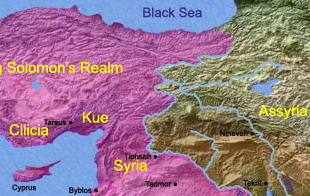 Que i.e. "Kue" |
| After the Death of Solomon: The Divided Kingdom 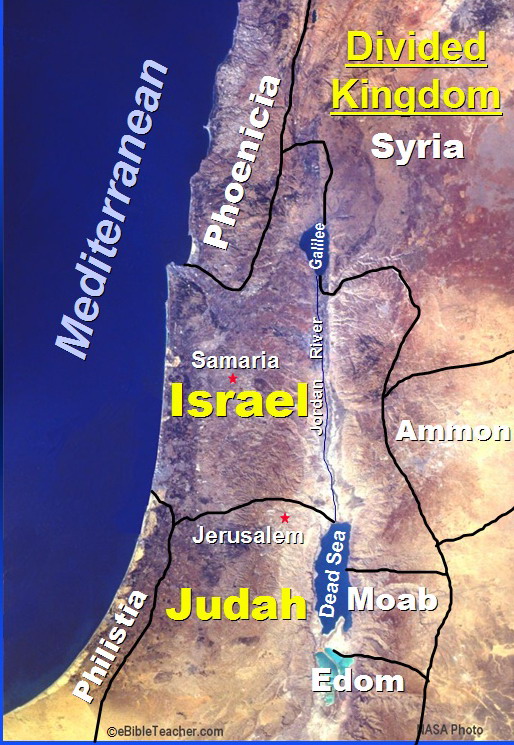 Source of Map: www.ebibleteacher.com/imagehtml/otmaps.html |
 1-Kings ch.9 |
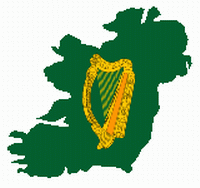 |
1-Kings ch.11  |